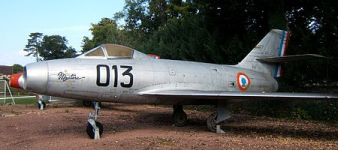Poker 2023-01 : un Rafale M catapulté avec un missile nucléaire ASMP-A
Translated with www.DeepL.com/Translator (free version)
Poker 2023-01: a Rafale M catapulted with an ASMP-A nuclear missile
Each year, the French Air Force organizes four nuclear air raid simulation exercises. Carried out at night, they are intended to reproduce as closely as possible the various stages of this strategic operation: refuelling, aircraft escort, firing (simulated) of an ASMP-A nuclear missile, etc. However, for the very first exercise of the year 2023, Poker 2023-01, the elements of the Strategic Air Forces of the French Air Force were also accompanied by aircraft of the French Navy's Nuclear Air Force, catapulted from the flight deck of the Charles de Gaulle, sailing in the Mediterranean Sea.
Three vectors, two of which are airborne
France's nuclear deterrent relies on three different delivery systems:
- the four Le Triomphant-class nuclear-powered ballistic missile submarines (SNLE), grouped together in the Force océanique stratégique (FOST) and equipped with 16 M51 strategic sea-to-ground missiles (mirvé, 6 to 10 warheads)
- the Rafale combat aircraft of the Strategic Air Forces (FAS) carrying an Air-Sol Medium-Range Improved missile (ASMP-A, single warhead)
- the Rafale M fighter planes of the Force aéronavale nucléaire (FANu), projected from the Charles de Gaulle aircraft carrier, also equipped with an ASMP-A
If this discreet and very secret dissuasion, it must be visible to dissuade but also to train in real conditions. With this in mind, the French Air and Space Force (AAE) organises the Poker exercise every year. Some exercises are also organised according to certain current events to remind the French power. On September 20, 2022, coincidentally or not*, while French President Emmanuel Macron was reading one of his toughest speeches at the UN (notably towards Russia and its decision to invade Ukraine), the AAE organised the Poker 2022-03 exercise.
Poker 2023-1
During the night of 2 to 29 March, the SAF organised Exercise Poker 2023-01, the very first strategic exercise for this year. The different aircraft involved simulated a strategic air raid in depth following a general pattern similar to previous Poker exercises (details in the article on Poker 2022-04);
- regrouping of the different aircraft of the raid on Brittany
- route to the target (Brittany -> Bay of Biscay -> Pyrenees -> Gulf of Lion)
- offensive phase, with aerial combat between the escort and EAF fighters simulating an opposition force (OPFOR) and the strategic aircraft simulating target shooting in central France, while avoiding anti-aircraft defence.
The third phase is quite noisy for many French people sleeping peacefully in the centre of France; the Rafales have to fly at low altitude at supersonic speed in order to reproduce as closely as possible the attack and release phase of the nuclear missile. It should be noted that this is one of the Air Force's major exercises: KC-135R, A330 MRTT, Rafale, E-3F Sentry, Mirage 2000-5, etc. are mobilised. Although the figures may vary, in general about fifty different aircraft are mobilised about four times a year! It is possible to follow them in real time on the live tracking sites: the KC-135R Stratotanker and A330 MRTT air-to-air refuelling tankers and the E-3F Sentry forward airborne warning and command aircraft (AEW&C) were visible.
Naval Aviation participates
This Poker exercise is special because, in addition to incorporating an alert take-off of the various aircraft of the Strategic Air Forces, the Strategic Naval Air Force was also involved in the exercise. For the occasion, at least one Rafale M was catapulted from the aircraft carrier Charles de Gaulle to participate in the raid. However, it is highly likely that the French Navy also launched other aircraft from the aircraft carrier to fully simulate an ANDF strategic raid;
- Rafale M in combat configuration
- Rafale M tanker (nanny)
- And possibly an E-2C Hawkeye (AEW&C)
It should be noted that the French Navy is currently the only navy in the world to have a strategic air and sea capability, thanks to the Rafale-ASMPA missile tandem. This capability had already raised questions a few years ago. However, in February 2023, Admiral Vandier, the current Chief of Staff of the French Navy, fully defended this capability: "[...] [The FANu] remains relevant because it broadens the portfolio of options for the head of the armed forces and makes the financial and technical efforts made to acquire an airborne force profitable. It is composed of a weapon system, logistics and operational standards identical to those of the Air and Space Force, with which joint training is organised.
He also stressed the protection and mobility offered by the Charles de Gaulle: "[...] on the aircraft carrier, the FANu takes advantage of the mobility of the platform [...] [which] constitutes a real air base, defended by considerable means and which can move more than 1,000 kilometres a day.
As for the vulnerability of the ship, he clearly confirmed that there is no such thing as an invulnerable system and that "In the course of a war, aircraft carriers are sunk, air bases are destroyed and aircraft are shot down."
The photo below, taken on the night of 28-29 March 2023, is one of the few images where it is possible to see an unblurred (for security reasons) ASMP-A mounted on a Rafale M.
Catapulting a Rafale M equipped with an ASMP-A missile from the Charles de Gaulle during exercise Poker 2023-01. French Navy, Sébastien Chenal
*The French Armed Forces give very little information about Poker exercises, let alone the decision to organise the exercise in question. However, a Poker exercise on the same day as the President's speech at the UN is probably not a coincidence.







